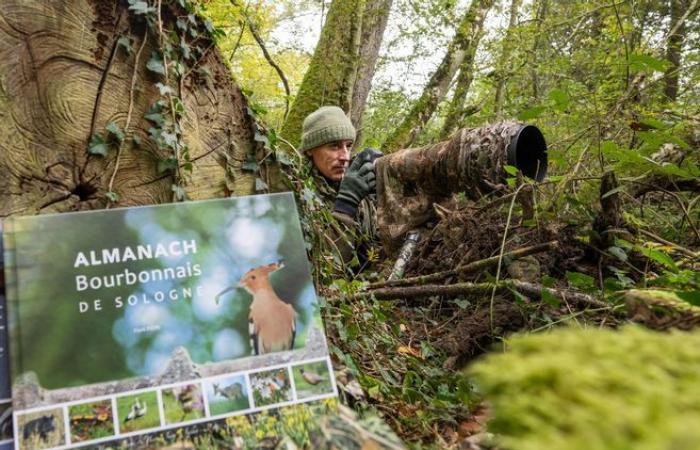The reader opens Almanach Bourbonnais de Sologne on January 1st and closes it on December 31st. Between these two dates, Frank Pizon offers a naturalistic, even initiatory journey.
What is the Bourbonnais Almanac of Sologne?
After Bourbonnais in nature and after Allier River in the heart of the Val d’Allier in Bourbonnaisthis work produced by Frank Pizon is the third volume in his series devoted to the nature of the department. Illustrated by multiple photos captioned with texts, this new opus finds its roots in Sologne. The book is in the original form of an almanac. The reader opens it on January 1 with the flight of a bird of prey and closes it on December 31 with the last sunset of the year. Between these two dates, it is a naturalistic, even initiatory, journey that the author offers. Images of animals in postures captured from life. Panoramic views of an authentically Bourbonnais built heritage. Close-ups of local landscapes whose singularity the photographer captures.
Frank Pizon presents his film “Allier, rivière sauvage” in preview in Moulins, before its broadcast on Arte
We are witnessing a close observation of the evolution of nature throughout the year. The images transcribe the metamorphoses of the environment… For 365 days.
The Bourbonnais Almanac, why? 365 days…
“The challenge is a bit crazy,” laughs Frank Pizon. But necessary to discover nature at the rhythm of its annual transformation: “So, meticulously, with patience and perseverance, I set about the task of living for a year at the rhythm of the countryside”. If some urban dwellers tend to associate rurality with slowness, Frank Pizon (de)shows, with supporting photos, that the reality is quite different:
Everything moves quickly in nature. This rapid sequence made my task more difficult to keep track of the main steps.
But this almanac woven throughout the seasons does not really pursue an ambition of completeness. It is more like a great contemplation, like an interior monologue turned outwards, like an ode to a countryside where everything coexists that makes Frank Pizon love this territory from which he himself comes:
There is no exuberance in Sologne Bourbonnaise. Don’t look for large naturalistic buildings or sumptuous palaces. It’s all about nuance, discretion. Everything is in a juxtaposition of the ordinary which requires observing things with discernment and acuity.
A biotope at a pivotal time.
Beyond the aesthetics and poetry emerging from this long-term journey into the Sologne nature, a strong concept emerges implicitly. Show that its biotope is at a pivotal period between a partly bygone past and a future with strong climatic variations. These hazards – floods, droughts, violent storms, etc. – are already having repercussions on the landscapes, on the fauna, on the flora:
Like the rest of France, Sologne must fight to maintain its environment alternating with ponds, small woods, fields, meadows. We clearly feel that we are at a time when nature is evolving and that it will undoubtedly no longer be the same tomorrow as it is today.
Frank Pizon immortalized it as it appears in the first half of the 21st century. As such, given the multiple uncertainties weighing on a future which could be marked by major upheavals, this almanac can already be considered as a precious testimony.
A meeting between nature and the Solognot dialect
In his Bourbonnais Almanac, Frank Pizon builds a bridge between Bourbonnais nature and the “speaking” of Sologne. This is one of the originalities of the book.
Young people facing public health issues: “We must take their words into account”, defends, in Allier, researcher Frank Pizon
Throughout the pages, to enhance the photos, we can read expressions in Solognot dialect: “At a time when things are disappearing in the composition of the seasons, like the dialect which is itself in decline. disappearing, I found it logical to bring together nature and dialect.”
In Almanac Bourbonnais, the Solognot patois is revealed as a language of everyday life, as a language of nature and the weather, as a language of day-to-day life in the countryside and of the events punctuating the seasons: “ So, I didn’t have to make any effort so that my photos were easily associated with expressions in patois,” explains Frank Pizon.
The starlings eat the tartarines that the beetles’ noses bite. This is to tell you that cows are bothered by flies which bite their noses but which will be eaten by birds.
Almanach Bourbonnais de Sologne (Editions Focalis, €39.90) is on sale in bookstores, in the Leclerc store network and the Gamm Vert store network. Frank Pizon will be signing Saturday November 30 at 2 p.m. at Cap Animal in Moulins; Saturday December 7 at 2 p.m. at the Gîtes de France de l’Allier headquarters, rue de l’Horloge in Moulins; Friday, December 13, at 4:30 p.m., at the Le Moulins aux lettres bookstore; Saturday December 14, at 2 p.m., at the E. Leclerc cultural space in Moulins.






